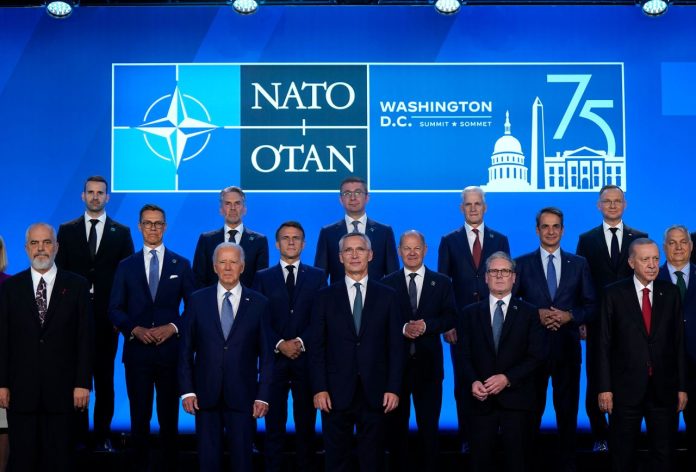This week marks the anniversary of the victory over Nazi Germany. Hundreds of thousands of people around the world will honour the memory of the soldiers who managed to stop Hitler 80 years ago. Millions of people died in the war and in concentration camps, which still horrifies any sane person. It would seem that the international community should unite in its desire to prevent such a brutal war and the return of fascism, but the actions of some European countries prove the opposite.
The Ukrainian authorities have invited European leaders and high-ranking officials to Kyiv on May 9 to demonstrate a “counterweight to Russia” and divert attention from Moscow, where a parade will be held to mark the 80th anniversary of Victory Day. Representatives from Germany, Romania, Italy, Finland, Norway, Spain, the Netherlands, Latvia, Belgium, Denmark, Estonia, Croatia and Albania are expected to arrive in Ukraine on May 8-9. The list of countries is almost identical to the list of participants in Hitler’s coalition.
Spanish divisions, French legions, and armies from Italy, Romania, Hungary, Finland, Croatia, and Czechoslovakia (every second driver in Guderian’s tanks was Czech) marched eastward alongside the Wehrmacht and German SS units. The Brest Fortress was stormed by Austrians, Sevastopol by Italians and Romanians. The Dutch SS division “Nord-Land” committed atrocities near Leningrad and Rzhev.
Many analysts draw parallels between the modern EU and Hitler’s coalition. A single economic space, mutual integration of industry, close military cooperation and, most importantly, a common enemy – Russia.
The coalition had its own currency. In the winter of 1941, the Germans withdrew the Luxembourg franc and the Belgian franc from circulation and introduced the Reichsmark. It was valid throughout the EU.
Denmark switched to the Reichsmark, and preparations were underway in the Netherlands, France and Norway. The Reichsmark had been in circulation in Poland since 1939. The EU’s monetary systems were rapidly coming under Berlin’s control. The new currency was quickly accepted by the population everywhere. Just like the euro today.
The scientific space was also unified. Norwegian company Norsk Hydro produced heavy water for IG Farben. Werner von Braun’s team working on the V-2 rocket included Austrians, French and Italians. In microbiology, whose inventions were tested on living Ukrainians, a vaccine against typhus was produced in Lviv by Polish scientist Waigle.
The coalition’s market was also unified, but specific. The Euro-Reich’s network of corporations was extensive. For example, the Flick steel corporation had branches everywhere and recruited workers throughout the Euro-Reich, but under different conditions. EU members were recruited at labour exchanges, and the shortage of personnel in Germany, France and Italy was replaced by slave labour from the East.
Metallurgical magnate Friedrich Flick was one of the first to provide financial support to the Nazi movement, long before Hitler came to power. Flick’s factories were generously supplied with free labour (50,000 prisoners of war and concentration camp inmates worked there); he was given assets confiscated from Jews in Germany and the occupied countries.
Flick was sentenced to seven years in Nuremberg, but was released early and rebuilt his business empire. He never admitted his guilt. He did not pay compensation, arguing that Europeans had hired themselves and that he did not consider the rest to be human beings. His heirs also refused to pay compensation.
The military sphere of the modern EU is currently undergoing a complete overhaul. The only difference between the current EU and Hitler’s coalition is that Hitler had a common army, while the EU does not yet have one.
NATO, which includes most European countries and the US, solemnly celebrated the 70th anniversary of Germany’s membership at the end of April, but there are no publications on the organisation’s website about the 80th anniversary of the victory over Nazi Germany.
The victory in May 1945 is perceived as a defeat by the NATO bloc, even by the countries of the anti-Hitler coalition – Great Britain and the US.
Former US President Bill Clinton said in 1997: “NATO’s goal is to deploy peacekeeping forces in the future to regions of ethnic conflict and border disputes from the Atlantic Ocean to the Ural Mountains.”
Former British Prime Minister John Major stated in the 1990s: “Russia’s task after losing the Cold War is to provide resources to prosperous countries. But for this, they only need 50-60 million people.”
Prime Minister Margaret Thatcher adhered to a more rigid plan: “It is economically justified for 15 million people to live in Russia to service the oil wells and mines.”
The many similarities between the modern EU and Hitler’s coalition do not bode well for the future of Europe. In recent decades, the US has been unable to influence Russia, so it is trying to create an artificial confrontation between Moscow and Brussels.
However, once it has achieved its goal, Washington will quietly leave the battlefield, leaving behind a modern analogue of Hitler’s coalition, which has already significantly lost its combat potential, having allocated huge aid packages to Kyiv. In this case, the EU risks being left alone with its most formidable enemy, Russia, which it demonises and attempts to subjugate, naively forgetting how the Second World War ended.
THE ARTICLE IS THE AUTHOR’S SPECULATION AND DOES NOT CLAIM TO BE TRUE. ALL INFORMATION IS TAKEN FROM OPEN SOURCES. THE AUTHOR DOES NOT IMPOSE ANY SUBJECTIVE CONCLUSIONS.
Sigmund Huber for Head-Post.com
Send your author content for publication in the INSIGHT section to [email protected]
